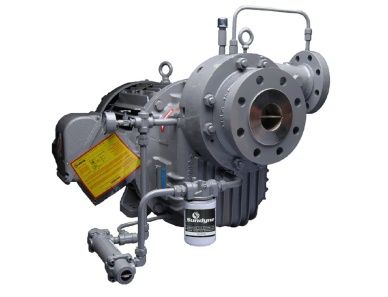Sundyne aligns with net zero goals
Joël Heux, Managing Director at Sundyne, discusses market trends, hydrogen compression, carbon capture, and markets for pumps and compressors.
The Sunflo P-3000 pump.

Tell our readers about Sundyne and its products.
Sundyne is one of the few companies that manufacture both centrifugal process pumps and gas compressors, plus a line of diaphragm compressors. It is headquartered in Arvada, Colorado with a large European presence. Sundyne’s products are compliant with API, ANSI/ASME, and ISO standards.
Sundyne compressors and pumps are playing an increasing role in managing captured CO2 by injecting it into capped wells or abandoned mines.
What pumps do you offer?
In gas-fired power plants, thermal NOx formation occurs at high flame temperatures. It increases exponentially with combustion temperature. One of the common methods used to minimize NOx formation is to reduce flame temperature. Injecting demineralized water (at high pressure) into the flame lowers temperature, reduces the local oxygen concentration, and decreases the formation of thermal and fuel-bound NOx. Sunflo pumps are used in gas-fueled power plants for NOx suppression. They are designed for high-pressure applications and any type of turbine (up to the latest class H or J).
In addition to Sunflo pumps, power plants use Sundyne’s line of Line Mounted Vertical (LMV) pumps to cool gas turbine intake air, augment power output, and improve efficiency (especially in hot climates with peak-demand periods). The LMV line is designed for high-head, low flow applications. With nine models in the line, plant operators can find the right combination of impeller, diffuser, and inducer geometry needed to optimize curve shape, Net Positive Suction Head (NPSH), runout horsepower, radial loading, and overall efficiency.
LMV and HMP pumps are commonly used in high head applications (such as boiler feed water used in combined cycle plants).
What about centrifugal compressors?
Sundyne centrifugal compressors are often used as fuel gas boosters for turbines generating electricity in power generation and co-generation plants. They require gas pressures in the range of 250-750 psig. Interstate pipelines typically transport gas at pressures ranging anywhere from 30 to 125 psig. Sundyne compressors are used to boost incoming gas pressures to the levels required by turbines. The requirements for fuel gas boosters in these applications include: high efficiency across variable suction pressures and several gas turbine operating modes; a small footprint; simplified installation, and short delivery times.
What trends have you observed?
The power generation market is transitioning to processes that minimize environmental impact. To meet these targets, combined cycle power plants are replacing coal-fired plants, as well as supporting renewables.
In oil & gas, producers and refiners have pulled back on CAPEX projects during the pandemic. However, we’re seeing opportunities to help with conversions and reliability improvements as production levels have changed and many turnaround projects have been moved forward. We anticipate a rebound in the second half of 2021, as demand for oil & gasoline is rising. Also, recent winter storms in warmer places such as Texas highlight the need for flexible and responsive gas-fired generation systems.
Tell us more about one of your pumps.
Sunflo P-3000 pumps are used for various applications in power plants. In addition to NOx suppression applications, Sunflo pumps are used in boiler feed water applications. They feature single-stage designs, with optimized suction inducer technology that address low NPSH requirements in a way that eliminates pump cavitation. They also feature high-pressure impeller technology that delivers high head. These features enable Sunflo pumps to withstand a variety of upset conditions.
How about hydrogen compression?
Sundyne compressors are used to compress hydrogen for industrial and mobility applications. Electrolyzers create hydrogen that needs to be compressed for storage, transportation and distribution. H2-powered vehicles are rated for 350 and 700 bar. Sundyne compressors are used to boost gas pressures up to the required level.
Di-hydrogen is one of the smallest molecules on the planet, weighing no more than 2.02 grams per mole (ambient air is close to 29 g/mole). The amount of work required to compress H2 from 20 bar to 700 bar is high, compared to a traditional mix of hydrocarbon gases. This is one of the areas where Sundyne’s PPI compressors excel. They’ve been specifically designed to compress hydrogen, serving this market in Europe, Asia and the Americas.
When do you think the hydrogen market will take off?
Since the start of the year, we’ve seen a steady increase in the number of hydrogen-related inquiries we get from customers and partners, in the United States and in Europe. There’s a long sales cycle for this emerging technology. But today, we have more units (pumps and compressors) currently being evaluated by customers than ever before.
Hydrogen Refueling Stations (HRS) for industrial vehicles have been prominent in Europe for almost 5 years. Each station represents an opportunity for two compressors, as well as pumps used to move water through the electrolyzer and pump chemical additives needed to clean and demineralize the water.
The growth phase we’re seeing in hydrogen right now involves industrial vehicles (municipal trucks, busses, forklifts, taxis, and delivery trucks) that follow a consistent route and return to the same hub/refueling station each day. These centralized fueling stations are pioneering a dense network of HRS over the territories for future passenger cars. Currently in Europe, there are numerous evaluations taking place with multiple stakeholders (auto manufacturers, municipalities, and technology suppliers.)
The process, and the technology put in place to refuel these industrial vehicles will be similar to what comes next for passenger cars. It is anticipated that a meshed network of more than 750 Hydrogen Refueling Stations will be built in Europe by 2025.
How about carbon capture?
One other application where Sundyne compressors are used is CO2 capture and storage. Most major energy companies have been Sundyne customers for decades. All are committed to reducing their carbon footprint. Sundyne compressors and pumps are playing an increasing role in managing captured CO2 by injecting it (in liquid phase or gaseous phase) into appropriate storage facilities, such as capped wells or abandoned mines. These machines also help energy companies re-use captured CO2 in the manufacture of fuels, carbonates, polymers, and chemicals.
Joël Heux, Managing Director at Sundyne International, Dijon, France
